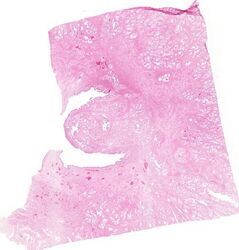16. Prostatic hyperplasia: Difference between revisions
(Created page with "'''Staining''': HE '''Organ''': Prostate '''Description''': We can see the characteristic half-moon shape of the urethra. The glands are abnormal, with a “starfish” shape because of the papillary structures opening into the glands. In some glands we can see a hyaline (glass-like) substance. The fibromuscular stroma is also abnormal. '''Diagnosis''': Benign prostate hyperplasia (BPH) '''Theory''': The hyaline substance in the glands are the prostatic concretions...") |
No edit summary |
||
| Line 1: | Line 1: | ||
'''Staining''': HE | [[File:BPH - overview.jpg|thumb|Overview. Kinda looks like the Turkish flag actually.|250x250px]]'''Staining''': HE | ||
'''Organ''': Prostate | '''Organ''': Prostate | ||
'''Description''': | '''Description''': We can see the characteristic half-moon shape of the urethra. The glands are abnormal, with a “starfish” shape because of the papillary structures opening into the glands. In some glands we can see a hyaline (glass-like) substance. The fibromuscular stroma is also abnormal. | ||
We can see the characteristic half-moon shape of the urethra. The glands are abnormal, with a “starfish” shape because of the papillary structures opening into the glands. In some glands we can see a hyaline (glass-like) substance. The fibromuscular stroma is also abnormal. | |||
'''Diagnosis''': Benign prostate hyperplasia (BPH) | '''Diagnosis''': Benign prostate hyperplasia (BPH) | ||
| Line 11: | Line 9: | ||
'''Theory''': | '''Theory''': | ||
The hyaline substance in the glands are the prostatic concretions or ''corpora amylacea'', which are characteristic for the prostate. | The hyaline substance in the glands are the prostatic concretions or ''corpora amylacea'', which are characteristic for the prostate. Normal prostatic glands have two layers: the inner ductal layer of epithelial cells and the outer myoepithelial layer. The glands present in BPH are similar but with intrusive papillary structures that give them a star-shape. | ||
Normal prostatic glands have two layers: the inner ductal layer of epithelial cells and the outer myoepithelial layer. The glands present in BPH are similar but with intrusive papillary structures that give them a star-shape | |||
The fibromuscular stroma is also hyperplastic. | Dihydrotestosterone (DHT) is a growth factor for prostatic cells. One theory regarding BPH states that a male “climax” (as in male menopause, not 💦) lowers the levels of DHT in the blood. In response to the lower level of DHT will the androgenic receptors be upregulated so that the DHT has a higher effect. DHT will then have an increased growth-inducing effect on the prostate. Local imbalance of growth factors like fibroblast growth factor (FGF) and vascular endothelial growth factor (VEGF) is also involved in BPH. The fibromuscular stroma is also hyperplastic.[[File:BPH - overview - stroma and concretions.jpg|thumb|left]] | ||
[[File:BPH - overview - stroma and concretions.jpg| | |||
[[File:BPH - glands.jpg|center|thumb|Glands]] | [[File:BPH - glands.jpg|center|thumb|Glands]] | ||
[[Category:Pathology 1 - Histopathology slides]] | [[Category:Pathology 1 - Histopathology slides]] | ||
Latest revision as of 11:22, 5 July 2024

Staining: HE
Organ: Prostate
Description: We can see the characteristic half-moon shape of the urethra. The glands are abnormal, with a “starfish” shape because of the papillary structures opening into the glands. In some glands we can see a hyaline (glass-like) substance. The fibromuscular stroma is also abnormal.
Diagnosis: Benign prostate hyperplasia (BPH)
Theory:
The hyaline substance in the glands are the prostatic concretions or corpora amylacea, which are characteristic for the prostate. Normal prostatic glands have two layers: the inner ductal layer of epithelial cells and the outer myoepithelial layer. The glands present in BPH are similar but with intrusive papillary structures that give them a star-shape.
Dihydrotestosterone (DHT) is a growth factor for prostatic cells. One theory regarding BPH states that a male “climax” (as in male menopause, not 💦) lowers the levels of DHT in the blood. In response to the lower level of DHT will the androgenic receptors be upregulated so that the DHT has a higher effect. DHT will then have an increased growth-inducing effect on the prostate. Local imbalance of growth factors like fibroblast growth factor (FGF) and vascular endothelial growth factor (VEGF) is also involved in BPH. The fibromuscular stroma is also hyperplastic.


